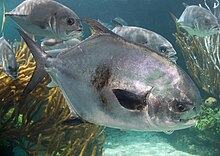Permit (fish)
| Permit | |
|---|---|
 |
|
| Scientific classification | |
| Kingdom: | Animalia |
| Phylum: | Chordata |
| Class: | Actinopterygii |
| Order: | Perciformes |
| Family: | Carangidae |
| Genus: | Trachinotus |
| Species: | T. falcatus |
| Binomial name | |
|
Trachinotus falcatus (Linnaeus, 1758) |
|
| Synonyms | |
|
Labrus falcatus Linnaeus, 1758 |
|
Labrus falcatus Linnaeus, 1758
The permit, Trachinotus falcatus, is a game fish of the western Atlantic Ocean belonging to the Carangidae family. Adults feed on crabs, shrimp, and smaller fish. Two submarines of the United States Navy were named USS Permit in its honor, in keeping with the "denizens of the deep" theme of submarine names that prevailed before the 1971 naming of USS Los Angeles.
The permit was first described by the "father of taxonomy", Carl Linnaeus in his tenth edition of the work Systema Naturae, which was published in 1758. He originally classified it as Labrus falcatus, though the fish has since been placed in the genus Trachinotus.
The permit's genus name, Trachinotus comes from a fusion of the Greek words trachys (), which means "rough", and noton (νωτον), meaning "back". The species name for the permit, falcatus, is a Latin adjective, which roughly means "armed with scythes". This serves as a reference to the permit's dorsal fin that occasionally protrudes from the water when schools of permit feed near the surface.
Permits can be distinguished by their elongated dorsal fins and anal fin. The dorsal fin is shaped like a scythe. Permit tails are also deeply forked, and their bodies are compressed laterally, making the fish tall and thin when viewed from the front.
...
Wikipedia

